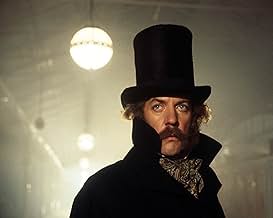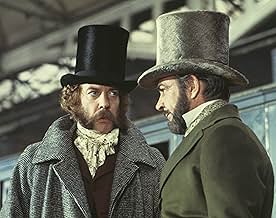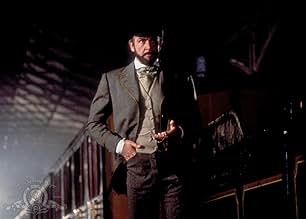VALUTAZIONE IMDb
6,9/10
20.755
LA TUA VALUTAZIONE
Inghilterra, 1850. Un maestro criminale mira a derubare un treno di una grossa somma d'oro. La sicurezza è incredibilmente stretta e il compito sembra impossibile.Inghilterra, 1850. Un maestro criminale mira a derubare un treno di una grossa somma d'oro. La sicurezza è incredibilmente stretta e il compito sembra impossibile.Inghilterra, 1850. Un maestro criminale mira a derubare un treno di una grossa somma d'oro. La sicurezza è incredibilmente stretta e il compito sembra impossibile.
- Premi
- 1 vittoria e 1 candidatura in totale
Brian de Salvo
- John - Trent's Butler
- (as Brian De Salvo)
André Morell
- Judge
- (as Andre Morell)
Recensioni in evidenza
The Great Train Robbery follows the standard heist movie blueprint. The team gets assembled to pull off an impossible job, they do all of the complicated prep work, then there is a last minute complication that makes it much more difficult than they expected. What stands out here is the setting, Victorian England, and the much smaller crew of thieves than usual. Most heist movies have a huge crew of 10+ characters that each need to have their characters explored. Here there is just the mastermind (Sean Connery), the pickpocket (Donald Sutherland), the girl (Lesley-Anne Downs), and the greaseman (Wayne Sleep). There are a few others, but their characters are so minor that they do not even get names. Rather than get sidetracked covering side characters, there is a strong focus on moving the plot forward that makes the entire movie more interesting.
What also stands out is the impressive stunts that were done mostly without stuntmen. Wayne Sleep really scales a wall and Sean Connery really walks across the top of a moving train. In today's CGI heavy film industry, it is refreshing to see an older movie that stays simpler with its big stunts, but they feel much realer, because they are. A lot of the movie relies on Sean Connery's natural charisma, which is the secret to a good heist movie, and Connery holds up very well compared to Clooney and Sinatra in the Ocean's movies and Newman and Redford in The Sting.
What also stands out is the impressive stunts that were done mostly without stuntmen. Wayne Sleep really scales a wall and Sean Connery really walks across the top of a moving train. In today's CGI heavy film industry, it is refreshing to see an older movie that stays simpler with its big stunts, but they feel much realer, because they are. A lot of the movie relies on Sean Connery's natural charisma, which is the secret to a good heist movie, and Connery holds up very well compared to Clooney and Sinatra in the Ocean's movies and Newman and Redford in The Sting.
Writing and directing The Great Train Robbery, Michael Crichton took much license with the facts of the story's basis, mostly to incorporate a tone of sardonic humor and mean-spirited mustachioed grinning. Sir Sean Connery has always been a great light comedian, having played Bond as a discreetly comic character. That's probably why Lazenby and Moore never totally matched him: They played 007 too orthodox. In Connery's charismatic oeuvre, master safecracker Edward Pierce is no exception.
The inimitable Donald Sutherland, playing a Victorian pickpocket and con man, is somewhat miscast as Connery's partner. He is not convincingly English, to my surprise frankly, though he does bring a new characteristic or two to virtually each film he's in, and here he's not just Connery's cohort but his foil. Leslie Ann Down plays Connery's moll and co-conspirator, and she appears to have been preordained to wear Victorian undergarments.
The plot for the heist is rather upfront: The train's safe, containing the gold, is protected with four keys, each in different hands. The challenge is to divide these holders from their keys, if possible in scenarios that serious, by-the-book Victorian gentlemen would be opposed to explaining to the police, so one aged banker is shadowed at a dogfight and another is intercepted in a brothel. There's also a Stopwatch Sequence for caper enthusiasts like me: Connery and Sutherland undergo numerous trials before endeavoring to burglarize the railway company office, and we get a gracefully stage-managed robbery effort with all the timeless taps like the guard reappearing a nanosecond after the critical moment and such.
One of the foremost amusements of this drum-tight caper is the way it's determinedly in the Victorian era. The costumes and the art direction are sincere, Crichton infuses his dialogue with undoubtedly genuine Victorian gangland wording, and, for the climactic train heist, they even constructed a whole operational train. Other gratifications: The nefarious deception used to smuggle Connery into the protected car with the gold; the chase sequence atop the train; and, certainly, the loin-scorchingly superb presence of Down, who is wryly funny in her own right.
An ornately thorough and exciting caper that parades historical accuracy in support of the tempting charisma of gentleman scoundrels up to no good. Connery and Sutherland are unscrupulous to their foundations but full of audacity and shrewdness. We're supportive of them all the way, with their dashing top hats, rustling coat-tails and panorama of facial hair.
There's a patent two-act structure to the proficient script. Crichton has a scientist's sensitivity to exactitude. First the crack team toil through the preparation phases, as they progressively appropriate indentations of the four keys necessary to unlock the safe, resulting in the heist itself on a train tearing through the British scenery. In the course of this era of steam power, it appeared a hopeless scheme. Meek, perhaps, by the wicked tempo of modern action sequences, Crichton nevertheless infuses a rousing realism with Connery mannishly performing his own stunts as he traverses the rooftop through clouds of grimy smoke, for the golden fleece.
All around, Crichton absorbs the tissue and texture of whimsical Victoriana from the bitter brick walls of the prison for Wayne Sleep's lithe prison escape to the plush, glossy furnishings of the brothel where the sexy Down slips a key from Alan Webb's frenziedly horny bank manager. But naturalism is not the approach, Crichton is after a giddy attribute like it's being told as a tall story in a pub sopping in overstatement and heightened deceit to whitewash impractical snags.
The inimitable Donald Sutherland, playing a Victorian pickpocket and con man, is somewhat miscast as Connery's partner. He is not convincingly English, to my surprise frankly, though he does bring a new characteristic or two to virtually each film he's in, and here he's not just Connery's cohort but his foil. Leslie Ann Down plays Connery's moll and co-conspirator, and she appears to have been preordained to wear Victorian undergarments.
The plot for the heist is rather upfront: The train's safe, containing the gold, is protected with four keys, each in different hands. The challenge is to divide these holders from their keys, if possible in scenarios that serious, by-the-book Victorian gentlemen would be opposed to explaining to the police, so one aged banker is shadowed at a dogfight and another is intercepted in a brothel. There's also a Stopwatch Sequence for caper enthusiasts like me: Connery and Sutherland undergo numerous trials before endeavoring to burglarize the railway company office, and we get a gracefully stage-managed robbery effort with all the timeless taps like the guard reappearing a nanosecond after the critical moment and such.
One of the foremost amusements of this drum-tight caper is the way it's determinedly in the Victorian era. The costumes and the art direction are sincere, Crichton infuses his dialogue with undoubtedly genuine Victorian gangland wording, and, for the climactic train heist, they even constructed a whole operational train. Other gratifications: The nefarious deception used to smuggle Connery into the protected car with the gold; the chase sequence atop the train; and, certainly, the loin-scorchingly superb presence of Down, who is wryly funny in her own right.
An ornately thorough and exciting caper that parades historical accuracy in support of the tempting charisma of gentleman scoundrels up to no good. Connery and Sutherland are unscrupulous to their foundations but full of audacity and shrewdness. We're supportive of them all the way, with their dashing top hats, rustling coat-tails and panorama of facial hair.
There's a patent two-act structure to the proficient script. Crichton has a scientist's sensitivity to exactitude. First the crack team toil through the preparation phases, as they progressively appropriate indentations of the four keys necessary to unlock the safe, resulting in the heist itself on a train tearing through the British scenery. In the course of this era of steam power, it appeared a hopeless scheme. Meek, perhaps, by the wicked tempo of modern action sequences, Crichton nevertheless infuses a rousing realism with Connery mannishly performing his own stunts as he traverses the rooftop through clouds of grimy smoke, for the golden fleece.
All around, Crichton absorbs the tissue and texture of whimsical Victoriana from the bitter brick walls of the prison for Wayne Sleep's lithe prison escape to the plush, glossy furnishings of the brothel where the sexy Down slips a key from Alan Webb's frenziedly horny bank manager. But naturalism is not the approach, Crichton is after a giddy attribute like it's being told as a tall story in a pub sopping in overstatement and heightened deceit to whitewash impractical snags.
The First Great Train Robbery is a first rate, seldom seen, crime thriller with Sean Connery, Lesley Ann Downes (who impresses in corsets) and Donald Sutherland who execute an audacious train heist...in England 1855 (with a little help from Wayne Sleep). Written with forensic prescison by Micheal Crichton, it staggers me that Sean Connery could have been considered box office poison with a project of this calibre.
Makes Buster look turgid - heartily recommended.
Makes Buster look turgid - heartily recommended.
This one is fun to watch as the thieves work an intricate plan to rob a train.
The performances are terrific, but the director and the late great Geoffrey Unsworth's delightful photography bring the Victorian Era back to life. The detail is wonderful in all the sets and surroundings.
The plot is very simple, the film is focused and I found myself rooting for the thieves!
The performances are terrific, but the director and the late great Geoffrey Unsworth's delightful photography bring the Victorian Era back to life. The detail is wonderful in all the sets and surroundings.
The plot is very simple, the film is focused and I found myself rooting for the thieves!
'The First Great Train Robbery' is about a quite impossible mission in Victorian underworld... It is about 25,000 pounds in gold bars placed in strongboxes and taken by armed security guards to the railway station...
'The First Great Train Robbery' is about the fastest pickpocket you'll ever see, a suave and daring gentleman who never tells the truth It is also about a bunch crooks that can steal your heart with the company of a fascinating disguised mistress who suspects that her father breaks his own regulation for each morning of the shipments...
'The First Great Train Robbery' chronicles the grandeur and hypocrisy at all levels of England during the Victorian Era, and proves that the cleverness and prowess of a criminal mastermind is elevated to heroic status...
With excellent photography of Ireland beautiful countryside, and great music score by Jerry Goldsmith, plus the costumes and sets, Michael Crichton's movie gives train heist's fans the pleasure to enjoy a very entertaining period thriller
'The First Great Train Robbery' is about the fastest pickpocket you'll ever see, a suave and daring gentleman who never tells the truth It is also about a bunch crooks that can steal your heart with the company of a fascinating disguised mistress who suspects that her father breaks his own regulation for each morning of the shipments...
'The First Great Train Robbery' chronicles the grandeur and hypocrisy at all levels of England during the Victorian Era, and proves that the cleverness and prowess of a criminal mastermind is elevated to heroic status...
With excellent photography of Ireland beautiful countryside, and great music score by Jerry Goldsmith, plus the costumes and sets, Michael Crichton's movie gives train heist's fans the pleasure to enjoy a very entertaining period thriller
Lo sapevi?
- QuizWriter and director Michael Crichton based his book and movie, only loosely on the actual crime committed in 1855. In real-life, there were four criminals: Pierce, Agar, the railway guard Burgess, and a railway clerk named Tester. All four keys were kept on railway premises, two in London, and two in Folkestone. They were stolen temporarily by Tester and Pierce, respectively, so that Agar could duplicate them, but it turned out that the Folkestone keys were not being used anyway. The guard's van was not locked from the outside; Pierce and Agar were let in by Burgess, and a share of the loot was handed out to Tester, at stations. None of the criminals were spotted at once; it was several months before the railway conceded that the crime must have occurred on the train. The details came to light after Agar had been convicted in an unrelated crime, and his accomplices decided to steal his share instead of using it, as he had asked, to provide his mistress an income. She got word to him, and he turned Queen's Evidence against the others, and told all. At no point in the case, did anyone escape from custody.
- BlooperIf the gold shipment was solely to pay British soldiers in Crimea, as asserted, it would have been in the form of barrels of gold coins, not gold bars as shown.
- Citazioni
Judge: [Judgementally] Now, on the matter of motive, we ask you: Why did you conceive, plan and execute this dastardly and scandalous crime?
Edward Pierce: I wanted the money.
[the court spectators roar with laughter]
- Curiosità sui creditiCóras Iompair Éireann is misspelled in the end titles with an accent over the 'C' instead of the 'o'.
- Versioni alternativeUnder the terms of the Cinematograph Films (Animals) Act 1937 all UK versions of the film are cut by 32 secs with edits to a scene where a dog hunts and kills rats in a show arena ('ratting').
- Colonne sonoreI Dreamt I Dwelt in Marble Halls
(uncredited)
Music by Michael William Balfe
Lyrics by Alfred Bunn (1843)
Heard on violin offstage in bordello
I più visti
Accedi per valutare e creare un elenco di titoli salvati per ottenere consigli personalizzati
Dettagli
- Data di uscita
- Paese di origine
- Lingue
- Celebre anche come
- 1855 - La grande rapina al treno
- Luoghi delle riprese
- Cork Kent station, Glanmire Road, Cork, County Cork, Irlanda(Brighton station)
- Aziende produttrici
- Vedi altri crediti dell’azienda su IMDbPro
Botteghino
- Budget
- 6.000.000 USD (previsto)
- Lordo Stati Uniti e Canada
- 13.027.857 USD
- Fine settimana di apertura Stati Uniti e Canada
- 391.942 USD
- 4 feb 1979
- Lordo in tutto il mondo
- 13.027.857 USD
- Tempo di esecuzione1 ora 50 minuti
- Colore
- Proporzioni
- 1.85 : 1
Contribuisci a questa pagina
Suggerisci una modifica o aggiungi i contenuti mancanti

Divario superiore
What is the Japanese language plot outline for 1855 - La prima grande rapina al treno (1978)?
Rispondi

































